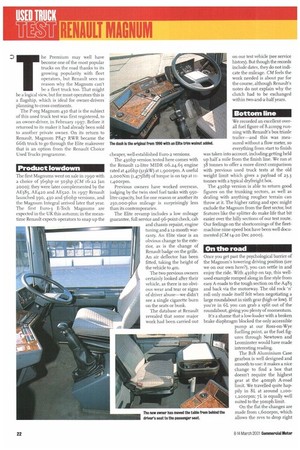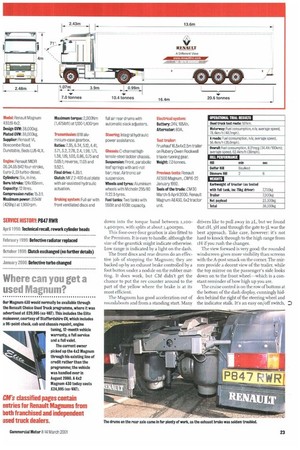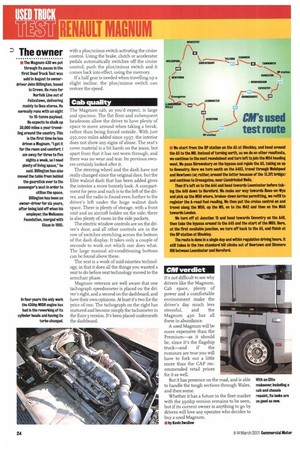T he Premium may well have become one of the most
Page 24

Page 25

Page 26

If you've noticed an error in this article please click here to report it so we can fix it.
popular trucks on the road thanks to its growing popularity with fleet operators, but Renault sees no reason why the Magnum can't be a fleet truck too. That might be a logical view, but for most operators this is a flagship, which is ideal for owner-drivers. planning to cross continents.
The P-reg Magnum 430 that is the subject of this used truck test was first registered, to an owner-driver, in February 1997. Before it returned to its maker it had already been sold to another private owner. On its return to Renault, Magnum P847 RWR became the 66th truck to go through the Elite makeover that is an option from the Renault Choice Used Trucks programme.
Product lowdown
The first Magnums went on sale in 1990 with a choice of 369hp or 5o3hp (CM 16-22 Jan 2000); they were later complemented by the AE385, AE420 and AE520. In 1997 Renault launched 390, 430 and 56ohp versions, and the Magnum Integral arrived later that year. The first Euro-3 E-Tech Magnums are expected in the UK this autumn; in the meantime Renault expects operators to snap up the
cheaper, well-established Euro-2 versions.
The 43ohp version tested here comes with the Renault i2-litre MIDR 06.24.65 engine rated at 426hp (3i3kW) ati,90orpm. A useful 2,000Nm (1,4751bft) of torque is On tap at
1,400rpm.
Previous owners have worked overseas, judging by the twin steel fuel tanks with 950litre capacity, but for one reason or another its 250,000-plus mileage is surprisingly less than its contemporaries.
The Elite revamp includes a low mileage guarantee, full service and 96-point check, cab and chassis repaint, engine tuning and am-month warranty An Elite visor is an obvious change to the exterior, as is the change of Renault badge on the grille. An air deflector has been fitted, taking the height of the vehicle to 4m.
The two previous owners certainly looked after their vehicle, as there is no obvious wear and tear or signs of driver abuse—we didn't see a single cigarette burn on the seats or bunk.
The database at Renault revealed that some major work had been carried out on our test vehicle (see service history). But though the records include dates, they do not indicate the mileage. CM feels the work needed is about par for the course, although Renault's notes do not explain why the clutch had to be exchanged within two-and-a-half years.
Bottom line
We recorded an excellent overall fuel figure of 8.21mpg running with Renault's box triaxle trailer—and this was measured without a flow meter, so everything from start to finish was taken into account, including getting held up half a mile from the finish line. We Tan at 38 tonnes to offer a more direct comparison with previous used truck tests at the old weight limit which gives a payload of 23.3 tonnes with a typical dryfreight box.
The 43ohp version is able to return good figures on the trunking sectors, as well as dealing with anything rougher terrain can throw at it The higher rating and spec might exclude the Magnum from the fleet sector, but features like the splitter do make life that bit easier over the hilly sections of our test route. Our feelings on the shortcomings of the fleetmachine nine-speed box have been well documented (CM14-20 Dec 2000).
On the road
Once you get past the psychological barrier of the Magnum's towering driving position (are we on our own here?), you can settle in and enjoy the ride. With 43ohp on tap, this wellused example romped along in fine style from easy A-roads to the tough section on the A483 and back via the motorway. The old rock 'n' roll only made itself felt when negotiating a large roundabout in sixth gear (high or low). If you're in 6L you can grab a split out of the roundabout, giving you plenty of momentum.
It's a shame that a low-loader with a broken brake diaphragm blocked the only accessible pump at our Ross-on-Wye fuelling point, as the fuel figures through Newtown and Leominster would have made interesting reading.
The Bi8 Aluminium Case gearbox is well designed and smooth to use: it makes a nice change to find a box that doesn't require the highest gear at the 4omph A-road limit. We travelled quite happily in 8L at around 1,100r,20 orpm; 7L is equally well suited to the 30mph limit.
On the flat the changes are made from 1,60orpm, which allows the revs to drop right down into the torque band between 1,100r,vorpm, with splits at about 1,400rpm.
This four-over-four gearbox is also fitted to the Premium. It is easy to handle, although the size of the gearstick might indicate otherwise. Low range is indicated by a light on the dash.
The front discs and rear drums do an effective job of stopping the Magnum; they are backed up by an exhaust brake controlled by a foot button under a nodule on the rubber matting. It does work, but CM didn't get the chance to put the rev counter around to the part of the yellow where the brake is at its most efficient.
The Magnum has good acceleration out of roundabouts and from a standing start. Many
drivers like to pull away in 2 L, but we found that iH, 3H and through the gate to 31_ was the best approach. Take care, however: it's not hard to knock through to the high range from iH if you rush the changes.
The view forward is very good: the rounded windscreen gives more visibility than screens with the A-post smack on the corner. The mirrors provide a decent view of the trailer, while the top mirror on the passenger's side looks down on to the front wheel—which is a constant reminder of how high up you are.
The cruise control is on the row of buttons at the bottom of the dash display, cunningly hidden behind the right of the steering wheel and the indicator stalk. It's an easy on/off switch, with a plus/minus switch activating the cruise control. Using the brake, clutch or accelerator pedals automatically switches off the cruise control; push the plus/minus switch and it comes back into effect, using the memory.
If a half gear is needed when travelling up a slight incline, the plus/minus switch can restore the speed.
Cab quality
The Magnum cab, as you'd expect, is large and spacious. The flat floor and subsequent headroom allow the driver to have plenty of space to move around when taking a break, rather than being forced outside. With just 250,000 miles added since 1997, the interior does not show any signs of abuse. The seat's cover material is a bit harsh on the jeans, but apart from that it has not worn through, and there was no wear and tear. Its previous owners certainly looked after it.
The steering wheel and the dash have not really changed since the original days, but the Elite walnut dash that has been added gives the interior a more homely look. A compartment for pens and such is to the left of the driver, and the radio is found even further to the driver's left under the huge walnut dash space. There is plenty of storage, with a front unit and an aircraft holder on the side; there is also plenty of room in the side pockets.
The electric window controls are on the driver's door, and all other controls are in the row of switches stretching across the bottom of the dash display. It takes only a couple of seconds to work out which one does what. The large manual air-conditioning buttons can be found above these.
The seat is a work of mid-nineties technology in that it does all the things you wanted a seat to do before seat technology moved to the armchair phase.
Magnum veterans are well aware that one tachograph speedometer is placed on the driver's right, and a second on the dashboard, and have their own opinions. At least it's two for the price of one. The tachograph on the right has matured and become simply the tachometer in the Euro3 version. It's been placed underneath the dashboard.
CM verdict
It's not difficult to see why drivers like the Magnum. Cab space, plenty of power and a comfortable environment make the driver's day much less stressful, and the Magnum 430 has all these in abundance.
A used Magnum will be more expensive than the Premium—as it should be, since it's the flagship truck—and if the rumours are true you will have to fork out a little more than the CAP recommended retail prices for it as well.
But it has presence on the road, and is able to handle the tough sections through Wales, and then some.
Whether it has a future in the fleet market with the 39ohp version remains to be seen, but if its current owner is anything to go by drivers will love any operator who decides to buy a used Magnum.
• by Kevin Swallow
































































































